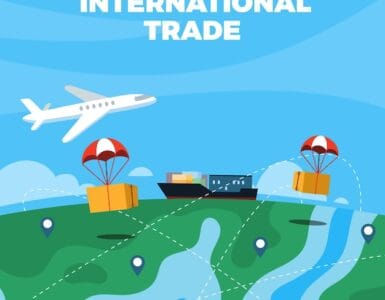Is trade good for Americans? People seem largely divided on the issue. A 2017 poll found that only 52 percent of Americans feel that trade agreements between the United States and other countries are good for the United States.1 However, unlike the general population, economists are overwhelmingly supportive of trade. A 2014 poll found that 93 percent of economists agree that past major trade deals have benefited most Americans.2 Given the consensus among economists, why is international trade, and the free-trade agreements that make it possible, so controversial?
Many people suspect that international trade operates as a zero-sum game. That is, they think it is like a sporting event—a competition with rules that ends with a winner and a loser. Specifically, people sometimes think that if our trading partners are gaining through international trade, the United States must be losing. In this view, exported goods represent a “win” for the economy and imported goods represent a “loss” for the economy.
This idea is nothing new; it dominated economic and political thought from the sixteenth to eighteenth centuries. Known then as mercantilism, it led to government policies that encouraged exports and discouraged imports. One of Adam Smith’s purposes in writing The Wealth of Nations (which helped establish economics as a distinct academic discipline) was to dispel the zero-sum game myth behind mercantilism.
Contents
The Costs and Benefits of Trade
In spite of people’s apprehension about trade, both imports and exports are at all-time highs (see the figure). As such, it’s important to understand why economists believe trade is good. Think back to the thriving trade in your elementary school cafeteria. Perhaps a friend across the table offered to trade her bag of grapes for your stack of crackers. You considered the costs and benefits of the transaction: The cost of the trade was the stack of crackers you would give up, and the benefit of the trade was the bag of grapes you would gain. Of course, you traded only if the perceived benefits (grapes gained) outweighed the perceived costs (crackers lost). And your friend agreed only if the perceived benefits (crackers gained) outweighed the perceived costs (grapes lost). Here is the economic lesson: For trade to occur, it must make both parties better off. This is a positive-sum game, not a zero-sum game, because both sides gain. However, this does not mean that everyone is better off. The costs and benefits of trade extend beyond the actual buyer and seller in the transaction. And, once third parties are included, it is clear that trade can create winners and losers.
The “Winners”
Just as the cafeteria trade demonstrated, both buyers and sellers benefit from trading. With international trade, the winners include consumers (buyers) and domestic companies that export goods (sellers). First, let’s discuss the benefits to buyers. Consumers see the benefits of trade in terms of variety and price. International trade ensures that consumers have access to a larger variety of goods and services. Think about some of the imported goods and brands that you buy on a regular basis. If imports were not available, your options would be more limited than they are now. In addition, many people buy imported goods and services when the prices of those imports are lower than the prices of domestic goods and services. This often occurs when producers in foreign countries can produce these goods and services at a lower cost than domestic producers. These lower costs often translate into lower prices, which benefit consumers by stretching their purchasing power. In addition, the competition provided by imported goods provides incentives for domestic producers to keep improving the quality of their goods while keeping prices low.
Domestic sellers also benefit from trade. Domestic companies that export have the world as their marketplace, not just the domestic economy. Producing for this larger market gives them the opportunity to grow and produce on a larger scale. These economies of scale enable them to take advantage of efficiencies and produce goods at a lower average cost. The lower production costs help make the companies more competitive and can result in lower prices for consumers.
Benefits of trade extend beyond the immediate buyers and sellers. Countries that engage in international trade benefit from economic growth and a rising standard of living. This occurs in two ways. First, trade gives countries access to physical capital (technology, tools, and equipment) that they might not produce domestically. This physical capital often results in increased productivity, which is a key driver of economic growth and a rising standard of living within a country.3 Second, access to global markets also increases export opportunities for developing economies. For example, China has become a manufacturing powerhouse4 and India has become a leader in exporting services.5 Both countries have experienced growth and development that might not have happened without access to global markets. Economists suggest that trade provides an avenue for the poorest nations to escape poverty. Recent research suggests that the removal of trade barriers could close the income gap between rich and poor countries by 50 percent.6
The “Losers”
At its core, international trade is similar to the cafeteria exchange—both buyers and sellers trade because both benefit from the transactions. Third parties, however, need to be taken into account because some are worse off from international trade. The most obvious third-party losers are companies that sell products that cannot compete in a global marketplace. These companies must find ways to make their products competitive or produce other products, or they risk going out of business. When businesses shut down, people lose jobs. This is painful for workers because many of them must learn new job skills to find new employment.
Net Benefits of Trade
Economists find that—after taking both the winners and losers into account—trade has net benefits for society. In other words, the benefits outweigh the costs. This does not seem obvious to many people because the costs are often more visible than the benefits. For example, it is relatively easy to identify businesses or industries that have shut down because of trade. Likewise, it is relatively easy to identify people who have lost jobs in those industries. Perhaps you know someone who has lost a job in this way. However, it is more difficult for consumers to identify how much cheaper their car, clothing, and food are because of international trade. In addition, the lower prices paid by consumers and businesses mean they have more money to spend on other goods and services. As a result, there are businesses that have experienced more growth as a result of that spending, which would not have happened without trade. But, again, those gains can be difficult to identify.
Policy Solutions
Those who suspect that trade might be hurting the economy sometimes propose “protectionist” measures, which are policies designed to protect workers from foreign competition (see the boxed insert). While these measures might save some jobs and industries, when trade volume is reduced, so are the benefits of trade. Economists often suggest policies that preserve the benefits of trade while addressing the costs, by compensating those who lose from trade. For example, many economists suggest that international trade should be left largely unregulated but that government should subsidize job-skills training programs for workers who have lost their jobs because of trade. The Trade Adjustment Assistance Program administered by the U.S. Department of Labor operates on this idea.7 In this way, the benefits of trade are preserved, but policy addresses the needs of those negatively affected by trade.
[“source=research.stlouisfed”]

















